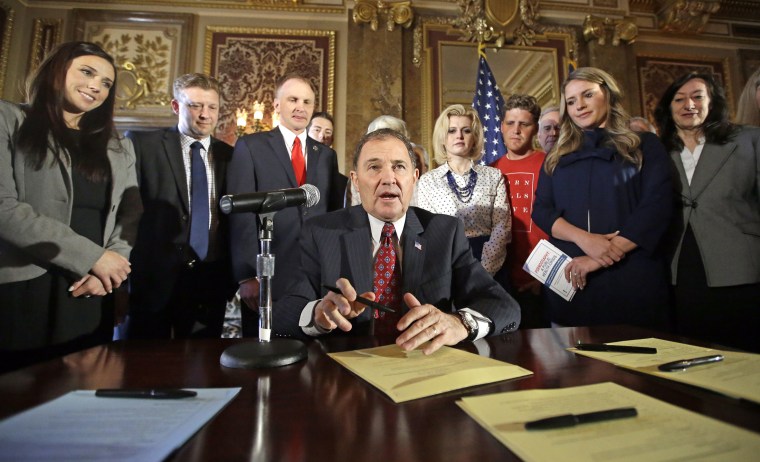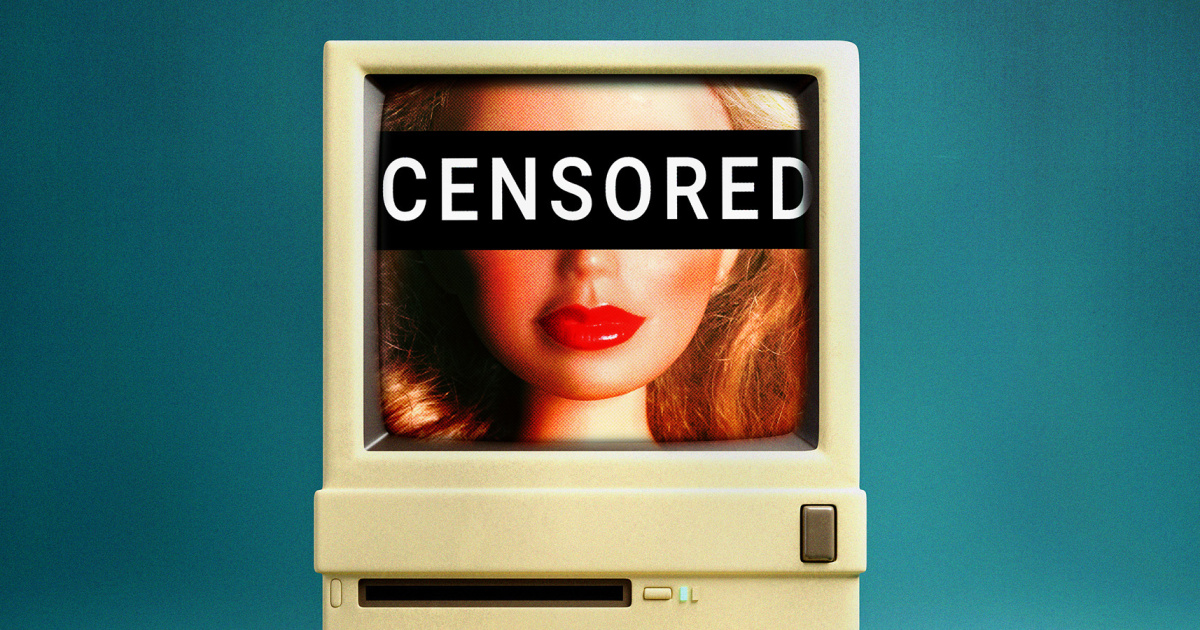
The strange bedfellows driving — and winning — the war on porn
Feminists, religious crusaders and “alpha male” influencers have turned the tide in the decades-old battle over adult content.
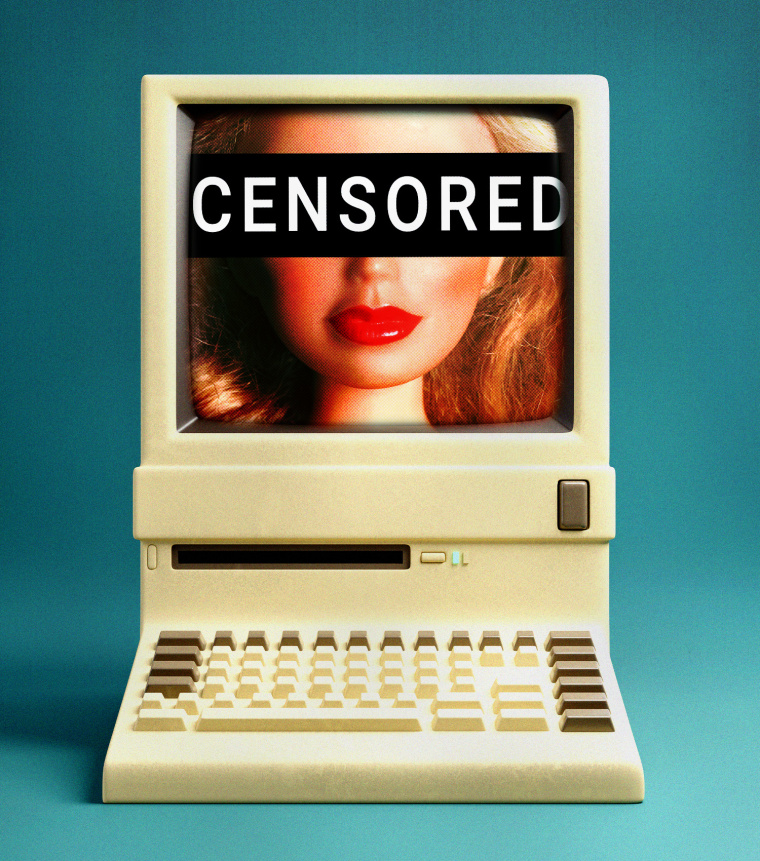
Culture & Trends
The strange bedfellows driving — and winning — the war on porn
Feminists, religious crusaders and “alpha male” influencers have turned the tide in the decades-old battle over adult content.
June 22, 2025, 6:00 AM EDT
By Pilar Melendez
Anti-pornography crusaders are on a winning streak.
On almost every front, those who argue that pornography is a scourge on society are racking up wins. States are implementing online age verification laws, and some politicians are pursuing aggressive bans on explicit content. Culturally, the viewpoint that porn is not only harmful to women but increasingly men and the sexual development of young people has made significant inroads.
As porn has become more mainstream, so has the discussion around it.
“Porn is bulls---. It is dangerous, not real, and a performance,” pop star Gracie Abrams said in a February interview with Cosmopolitan. “It’s really dangerous for young people for that to be their introduction to sex.”
Once viewed as a fringe moral crusade, the war against porn has ballooned into a multipronged, mainstream force over the past decade that now counts feminists, religious crusaders, alpha male influencers and a growing number of politicians among its ranks. And after several key social and legislative wins, the movement faces its biggest test. A Supreme Court ruling this summer is set to determine whether a Texas law, which mirrors legislation in over a dozen states and requires porn websites to confirm a visitor’s age or face financial penalties in the name of protecting minors from explicit content, infringes on the First Amendment rights of adults.
And it’s not just about age verification. Last month, Sen. Mike Lee, R-Utah, introduced the Interstate Obscenity Definition Act bill to alter the definition of obscenity under the Communications Act of 1934 and criminalize the transmission across state lines of content deemed obscene. Although the bill has a long, challenging path toward becoming a law, it seeks to label content obscene if it simply focuses on nudity or sex in a way intended to arouse or lacks “serious literary, artistic, political, or scientific value.”
Free speech advocates and those in the porn industry are concerned.
“It certainly raises alarm bells because this is about more than porn,” Mike Stabile, the public policy director for the Free Speech Coalition, a trade and advocacy organization for the adult entertainment industry, said about the anti-porn legislative momentum. “These are backdoor censorship bills. Porn is the Trojan horse here.”
Many in the adult content world are not entirely against age verification. And while the actual adverse effects of porn remain the subject of intense debate — and growing academic study — it is undeniable that a once fringe and taboo world has become part of the mainstream. One 2023 study found that more people visited the top three porn sites monthly than TikTok, Zoom, Amazon, OpenAI or Netflix. Meanwhile, the rise of OnlyFans has redistributed the money and power of adult content.
But just how “bad” is porn? That, too, remains a heated subject. Rigorous academic and scientific work has done little to turn up definite harms. Still, porn industry leaders have acknowledged their ongoing battle with deepfakes, underage content and revenge porn, including Pornhub, which removed millions of unverified videos from its website in 2020 following allegations that the site showed problematic content.
It’s against that backdrop that many anti-porn crusaders see their movement thriving, in large part as a backlash to just how much porn has evolved from the back rooms of video stores, adult magazines and pay-per-minute phone services.
Gail Dines, a key figure in the anti-porn movement for over 30 years, said the goal isn’t necessarily to ban porn. But if that happens, porn only has itself to blame.
“The porn industry sowed the seeds of its own destruction,” Dines said.
Pre-internet and the porn ‘public health issue’
Pornography has quite a history, by some measures dating back thousands of years. And though the anti-pornography movement doesn’t have quite the same track record, its presence in the U.S. has been well documented for decades.
Marty Klein, a certified sex therapist and the author of “America’s War on Sex,” said that the pushback on porn can be traced back to at least the 1950s, when it was primarily coming from religious circles. However, the scope of the issue remained relatively small: Playboy magazine, dirty books and the odd film.
Porn as it might be thought of today took its first steps into the mainstream in the late 1960s and early 1970s, as some adult films saw wider releases. That coincided with the anti-porn movement’s first legal win, when the Supreme Court ruled in 1973 that states were allowed to restrict obscene content based on “community standards.” The ruling came just months after Roe v. Wade was decided.
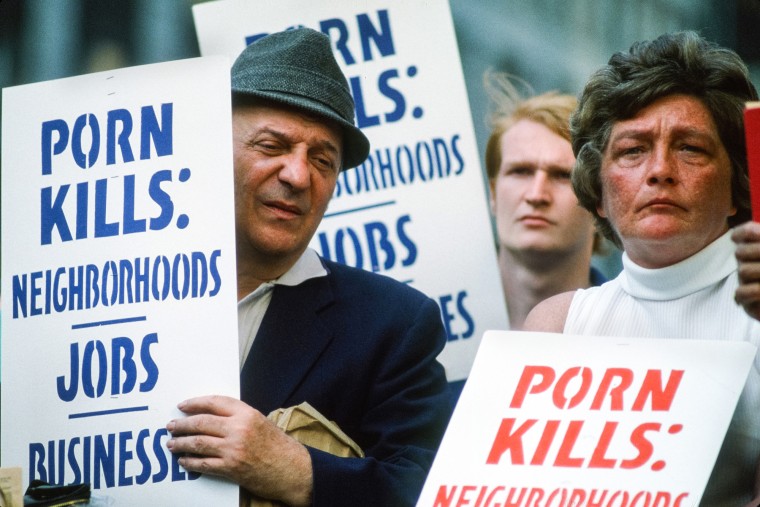
Demonstrators protest against pornography in Times Square in New York City in 1979.Leif Skoogfors / Getty Images file
“Roe v. Wade energized the right … and looked to control the idea of sexuality,” Klein said.
The idea of control, he said, pivoted the fight against porn from a moral issue to a public health one, a move that dovetailed with some feminist critiques. But the work by these feminists, like Andrea Dworkin and Catharine MacKinnon, to create anti-porn legislation (which focused on civil legal remedies for those impacted by the industry and labeling adult entertainment as a women’s civil rights violation) never stuck.
Dines explained that by the 1990s, the third wave of neoliberal feminism took hold, reconceptualizing the movement in the name of empowerment and sexual freedom.
“Instead of it being about exploitation, it became about empowerment and liberation, empowerment and agency, and that this is how women display their sexuality,” Dines said. “This was mainly written by women who were academics who had not had any contact in the porn industry.”
By the early 2000s, the war against porn was most publicly helmed by Focus on the Family and Morality in Media, which launched campaigns to ban adult magazines and prosecute obscenity violations. Those efforts, however, rarely succeeded in court and didn’t make more traction socially as Americans began to see pornography as a private, personal freedom.
The rise of the internet, however, had already begun to make the fight against printed adult content seem quaint. Pornography was suddenly going to be easily accessible to anyone with an internet connection.
The internet, OnlyFans and the new anti-porn wave
Those on both sides of the porn debate agree that the internet changed everything for the adult entertainment industry.
“Pornhub and other free porn sites soon became the wallpaper of boys’ and men’s lives,” Dines said. “It was affordable, accessible and anonymous. You could watch it in your own home.”
Studies about the consumption of pornography vary in their claims, and many have come from interested groups, but it is generally accepted that porn is incredibly common. The digital footprint of porn only grew with the rise of smartphones, laptops and social media. A 2023 Pew Research study found that nearly half of teenagers ages 13 to 17 say they are online “almost constantly,” at a rate that has almost doubled since 2014.
Dines was among the scholars on the front lines against porn, arguing that porn trains young men to dehumanize women and normalizes sexual aggression. This framing was further boosted by campaigns like Fight the New Drug, a nonreligious nonprofit that argues porn is analogous to a drug.
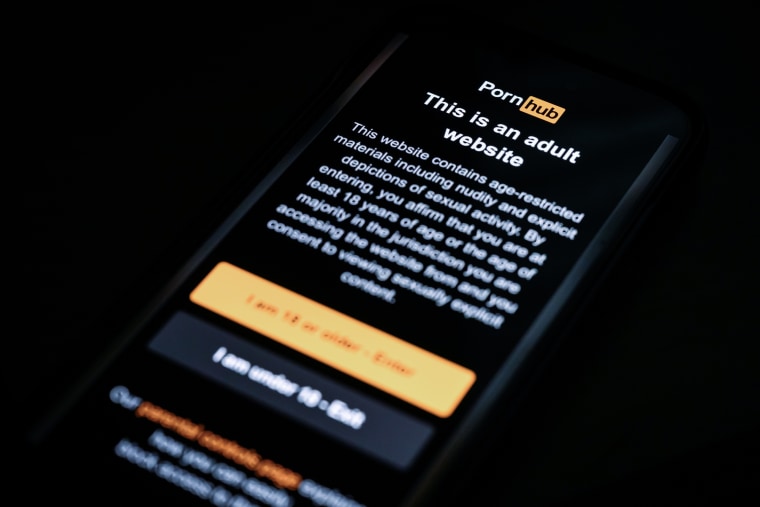
The age-restriction warning screen of the website Pornhub.Leon Neal / Getty Images file
Those ideas have percolated in some corners of the internet for years. With the growing ubiquity of online porn, no-porn subcultures also began to emerge in the name of helping men and confronting the impacts of “centerfold syndrome,” a term coined in the 1990s to explain a fixation on hypersexualized images of women that can lead to a fear of personal inadequacy and difficulty having sexual relationships. Among the loudest advocates against porn in the name of men’s health was Gary Wilson, the author of “Your Brain on Porn” and the founder of a website with the same name.
Wilson, a former teacher who died in 2021, blended neuroscience and anecdotal evidence to argue that porn rewires the brain like a drug. Though criticized by many in the academic community, Wilson’s now-infamous TED talk “The Great Porn Experience” is often cited as laying the groundwork for pro-abstinence, anti-porn internet subcultures.

